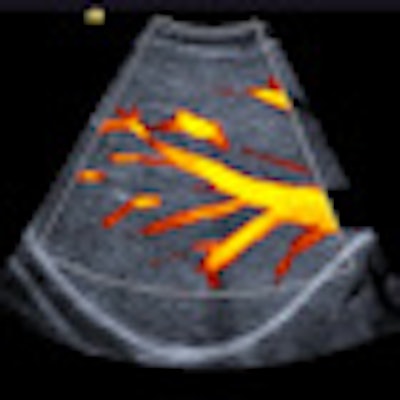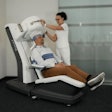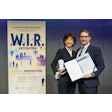
Innovative compact systems and new clinical applications have broadened the spectrum of ultrasound use and topped industry headlines recently. Yet in 2010, more than 76% of ultrasound systems were sold into three core applications: radiology, obstetrics and gynecology, and cardiology. So are manufacturers focusing enough on development and innovation for end users?
A brace of new product releases, exhibited at the recent World Federation for Ultrasound in Medicine and Biology (WFUMB) 2011 congress in Vienna, suggests improvements in "core" ultrasound technology will have significant benefit for most users. New systems on show were clearly based on three principles: image quality, ease of use, and flexibility.
 The Austria Center was the venue for the 2011 World Federation for Ultrasound in Medicine and Biology (WFUMB) congress. Image courtesy of Mélisande Rouger.
The Austria Center was the venue for the 2011 World Federation for Ultrasound in Medicine and Biology (WFUMB) congress. Image courtesy of Mélisande Rouger.
Most obvious in demonstrating this trend was Philips Healthcare's ClearVue series. To look at, the slimmer system may appear very basic; in fact, technology and innovation have been used in a subtler way. So-called Active Array technology integrates key beam-forming circuitry into the transducer itself, resulting in lighter weight cabling and less cumbersome scanning. Furthermore, the modular design of the system allows easier part replacement for servicing and maintaining the system, according to the vendor.
At WFUMB, GE Healthcare announced the release of the Signature series, for both the Voluson S8 and S6 platforms. This range boasts a number of innovations, intended to provide improvements in workflow, ease of use, image quality, and automated measurement.
Toshiba Medical Systems showcased three new systems at the exhibition: the Aplio 300, 400, and 500. The new Aplio range provides a number of features with intriguing potential for advanced imaging applications. Most striking is the FlyThru feature, enabling visualization of volume datasets from within, like a "virtual endoscopy." Also of note, Toshiba has joined an increasing number of providers offering image fusion technology. The Smart Fusion feature allows real-time "fusion" of CT, MR, and 3D ultrasound images, utilizing an integrated positioning sensor within the transducer.
For routine everyday imaging, small innovations such as transducer size reduction, lighter cabling, automated measurements, and simpler user interface can dramatically reduce examination time. Less bulky systems and a wider range of features also increase flexibility, allowing systems to be shared between clinics, increasing utilization and cost-efficiency. These positives, combined with the relative low-cost of ultrasound compared with other modalities, provide a compelling argument for hospitals and clinics to invest in new systems.
For advanced imaging studies, improvements in beam forming, signal processing, and matrix transducer technology allow faster and higher resolution imaging. Paired with new visualization and image-rendering software, the limits of what is diagnostically possible with ultrasound are being rapidly advanced.
Furthermore, this is having a positive impact on the clinical reputation of ultrasound, particularly in radiology. In the past decade, many radiologists have dismissed ultrasound for advanced diagnostic studies, preferring instead the greater anatomical detail provided by MRI and CT. However, concerns regarding cost, radiation dosage and inflexibility of MRI and CT, paired with improvements in ultrasound technology, are rapidly altering this view.
The impact of these new releases may not grab the headlines as with the advent of compact ultrasound, or drive rapid penetration into new markets in the same way. However, it does signal a subtler transition to a new generation of more intelligent, user-friendly ultrasound systems.
Simplification of ultrasound remains the key challenge for providers, and will promote greater use of ultrasound in clinical diagnosis. It is also essential for more regular use of advanced features, such as image fusion, elastography, and contrast enhanced ultrasound.
User education and training are also vital. Investment in promoting the benefits of ultrasound in new point-of-care markets has been crucial to its success so far. Unless users are made aware of the clinical benefits of ultrasound for diagnosis, they will continue to undervalue its potential.
The new generation of smarter, simpler, cost-effective ultrasound technology, operated by well-trained and educated users, can have wide-ranging economic and clinical benefits for healthcare providers. Most important, it will undoubtedly improve the quality of patient care and clinical diagnosis.
The image on the home page is a power Doppler examination of the hepatic veins (TR view). Image courtesy of Siemens Healthcare.
Stephen Holloway is lead analyst for medical imaging research at InMedica, and author of InMedica's global ultrasound reports. The company recently published "The World Market for Ultrasound Imaging Equipment -- 2011 edition" report. For more details, visit www.in-medica.com.
The comments and observations expressed herein do not necessarily reflect the opinions of AuntMinnieEurope.com, nor should they be construed as an endorsement or admonishment of any particular vendor, analyst, industry consultant, or consulting group.



















